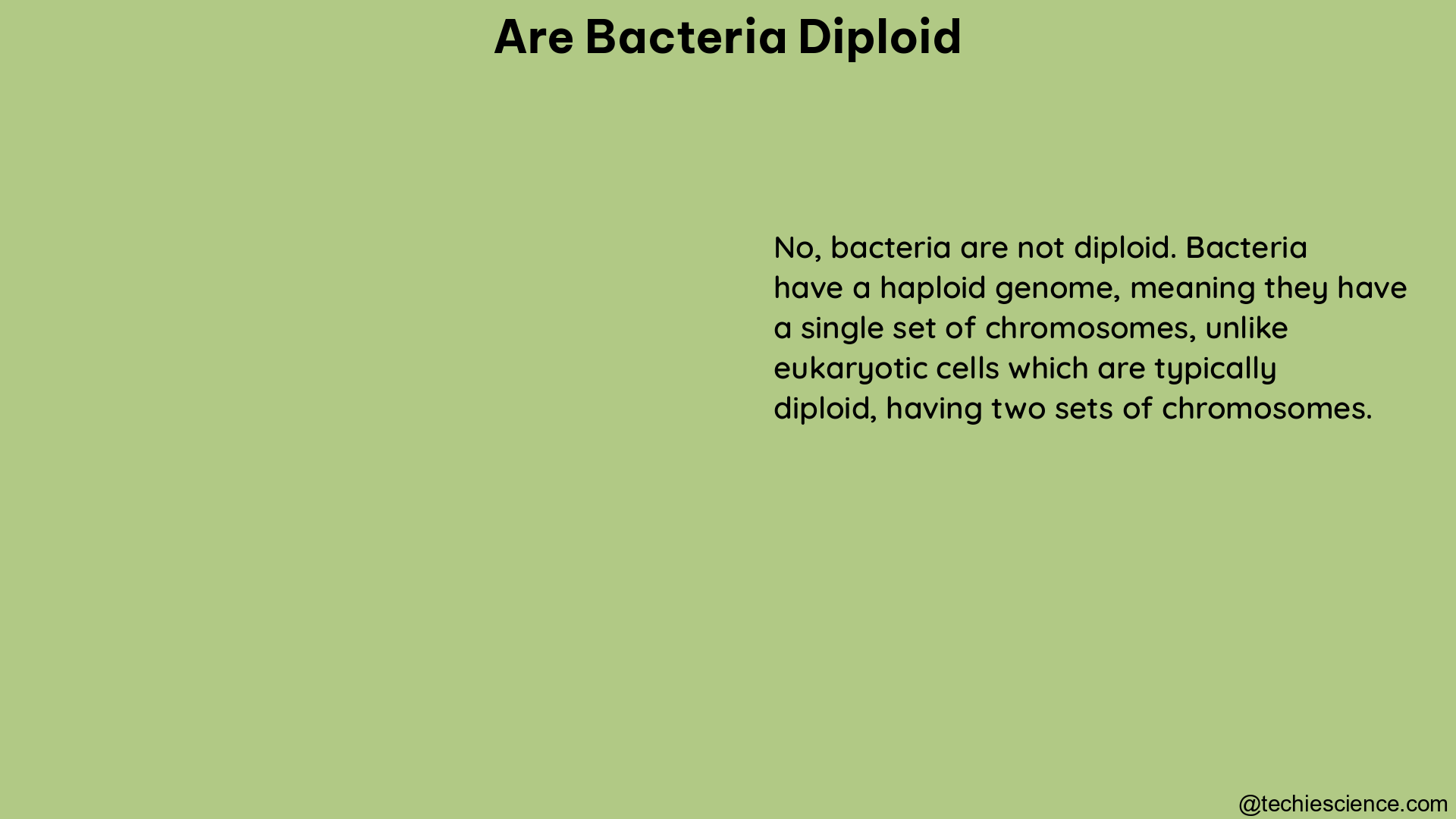Bacteria are typically known for their haploid nature, possessing a single copy of their genetic material. However, there are some exceptions to this general rule, and understanding the nuances of bacterial ploidy is crucial for a comprehensive understanding of microbial biology.
Bacterial Ploidy: The Norm and the Exceptions
Bacteria are predominantly monoploid, meaning they contain a single copy of their chromosome. This is the most common and well-understood state of bacterial genomes. However, there are a few notable exceptions to this rule:
- Lactococcus lactis: The laboratory strains MG1363 and IL1403 of this lactic acid bacterium are known to be diploid, possessing two copies of their chromosome.
- Dairy Strains of Lactococcus lactis: In addition to the laboratory strains, several dairy-associated strains of Lactococcus lactis have also been observed to be diploid.
- Escherichia coli: While the majority of E. coli cells are monoploid, subpopulations of this bacterium can become diploid through the process of DNA replication. However, these diploid cells are not stable and eventually revert to the monoploid state.
Ploidy and Bacterial Community Composition

Interestingly, the ploidy level of bacteria can have measurable effects on the composition of bacterial communities. A study of the wheat root-associated bacterial microbiome revealed that ploidy level correlated with subtle changes in community structure:
- Actinobacteria: This bacterial class was present in greater relative abundance in polyploid root samples.
- Lower Abundant Classes: Several less abundant bacterial classes were only detected in the polyploid fractions, particularly in the rhizosphere (the soil immediately surrounding the roots).
These findings suggest that variations in ploidy level can influence the relative abundance and distribution of different bacterial taxa within a given microbial community.
Genome Copy Number Diversity in Proteobacteria
A study of four proteobacterial species, a diverse group of gram-negative bacteria, revealed a wide range of genome copy numbers:
| Species | Ploidy Level |
|---|---|
| Caulobacter crescentus | Monoploid |
| Azotobacter vinelandii | Mono-/Oligoploid and Polyploid (depending on growth conditions) |
This diversity in genome copy number highlights the fact that bacterial ploidy is not a one-size-fits-all phenomenon, and can vary significantly even within a single taxonomic group.
Factors Influencing Bacterial Ploidy
The factors that contribute to the establishment and maintenance of bacterial ploidy are not fully understood, but several potential mechanisms have been proposed:
- Environmental Conditions: The ploidy level of some bacteria, such as Azotobacter vinelandii, can be influenced by growth conditions, with different ploidy states observed under varying environmental circumstances.
- Genome Replication Dynamics: The process of DNA replication in bacteria can sometimes result in the temporary formation of diploid cells, as seen in Escherichia coli. However, these diploid cells are not stable and eventually revert to the monoploid state.
- Evolutionary Advantages: The maintenance of diploid or polyploid states in certain bacterial species, such as Lactococcus lactis, may confer some evolutionary advantages, though the specific benefits are not yet fully elucidated.
Implications and Future Directions
The understanding of bacterial ploidy has important implications for various fields, including:
- Microbial Ecology: The influence of ploidy on bacterial community composition suggests that this factor should be considered when studying the dynamics and interactions within complex microbial ecosystems.
- Biotechnology and Industrial Applications: The ploidy state of bacteria used in industrial processes, such as fermentation or bioremediation, may impact their performance and productivity, warranting further investigation.
- Evolutionary Biology: The existence of diploid and polyploid bacteria raises questions about the evolutionary mechanisms and selective pressures that have led to the maintenance of these ploidy states in certain species.
As our understanding of bacterial ploidy continues to evolve, further research is needed to elucidate the underlying mechanisms, the ecological and functional implications, and the potential applications of this knowledge in various scientific and industrial domains.
References:
- Gao, B., & Gupta, R. S. (2012). Phylogenetic framework and molecular signatures for the main clades of the phylum Actinobacteria. Microbiology and Molecular Biology Reviews, 76(1), 66-112.
- Klappenbach, J. A., Dunbar, J. M., & Schmidt, T. M. (2000). rRNA operon copy number reflects ecological strategies of bacteria. Applied and Environmental Microbiology, 66(4), 1328-1333.
- Sánchez-Romero, M. A., & Casadesús, J. (2020). The bacterial epigenome. Nature Reviews Microbiology, 18(1), 7-20.
- Sørensen, S. J., Bailey, M., Hansen, L. H., Kroer, N., & Wuertz, S. (2005). Studying plasmid horizontal transfer in situ: a critical review. Nature Reviews Microbiology, 3(9), 700-710.
- Yoon, S. H., Ha, S. M., Kwon, S., Lim, J., Kim, Y., Seo, H., & Chun, J. (2017). Introducing EzBioCloud: a taxonomically united database of 16S rRNA gene sequences and whole-genome assemblies. International Journal of Systematic and Evolutionary Microbiology, 67(5), 1613-1617.

Hi….I am Aheli Dey, I have completed my Masters in Zoology. My specialization is in Parasitology and Immunology. I am very enthusiastic in learning new things. I prefer both hard and smart work.